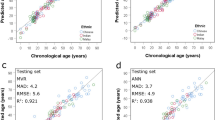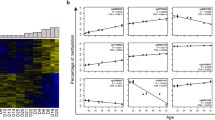Abstract
In forensic investigations, age estimation is vital for determining whether a suspect is under or over the legally defined adult age. With breakthroughs in RNA sequencing technology, small noncoding RNAs have provided new ways to solve problems related to the age estimation of trace or aged samples, owing to their small molecular weight and better stability. In our previous study, we had applied miRNAs for the age estimation of bloodstains; however, further improvement of the existing model is needed. PIWI-interacting RNAs (PiRNAs), which are 24–32 nt noncoding small RNA molecules involved in the PIWI-piRNA pathway, play an important role in the aging process. In this study, we explored the possibility of simultaneously analyzing piRNAs and miRNAs for better age estimation purpose. Through massively parallel sequencing, five age-related piRNAs were identified in blood samples that had been stored for eight years. Further real-time PCR analysis revealed that two piRNAs (piR-000753 and piR-020548) showed relatively higher efficiency in age estimation. Additionally, two age-related miRNAs (miR-324-3p and miR-330-5p) were used to build the estimation model. Among all algorithms tested, gradient boosting showed the lowest mean absolute error (MAE) and root mean square error (RMSE) values (3.171 and 4.403 years, respectively) for the validation dataset (n = 110). The errors of the model were less than 5 years and 10 years for 81.82% and 96.36% of the samples, respectively. The results suggest that the combined use of piRNA and miRNA markers may increase the accuracy of age estimation, and our new model has great potential for application in forensic casework.




Similar content being viewed by others
References
Deng XD, Lu T, Liu GF et al (2022) Forensic age prediction and age classification for critical age thresholds via 3.0T magnetic resonance imaging of the knee in the Chinese Han population. Int J Legal Med 136:841–852. https://doi.org/10.1007/s00414-022-02797-y
Correia Dias H, Manco L, Corte Real F, Cunha E (2021) A Blood-Bone-Tooth Model for Age Prediction in Forensic Contexts. Biology (Basel) 10:1312. https://doi.org/10.3390/biology10121312
Valsecchi A, Irurita Olivares J, Mesejo P (2019) Age estimation in forensic anthropology: methodological considerations about the validation studies of prediction models. Int J Legal Med 133:1915–1924. https://doi.org/10.1007/s00414-019-02064-7
Montesanto A, D’Aquila P, Lagani V et al (2020) A New Robust Epigenetic Model for Forensic Age Prediction. J Forensic Sci 65:1424–1431. https://doi.org/10.1111/1556-4029.14460
Correia Dias H, Cunha E, Corte Real F, Manco L (2020) Age prediction in living: Forensic epigenetic age estimation based on blood samples. Leg Med (Tokyo) 47:101763. S1344-6223(20)30097-3
Goto H, Iwata H, Takeo S et al (2013) Effect of bovine age on the proliferative activity, global DNA methylation, relative telomere length and telomerase activity of granulosa cells. Zygote 21:256–264. https://doi.org/10.1017/S0967199411000499
Theves C, Keyser-Tracqui C, Crubezy E, Salles JP, Ludes B, Telmon N (2006) Detection and quantification of the age-related point mutation A189G in the human mitochondrial DNA. J Forensic Sci 51:865–73. JFO163. https://doi.org/10.1111/j.1556-4029.2006.00163.x
Aliferi A, Ballard D (2022) Predicting Chronological Age from DNA Methylation Data: A Machine Learning Approach for Small Datasets and Limited Predictors. Methods Mol Biol 2432:187–200. https://doi.org/10.1007/978-1-0716-1994-0_14
Pavanello S, Campisi M, Rigotti P et al (2022) DNA Methylation - and Telomere - Based Biological Age Estimation as Markers of Biological Aging in Donors Kidneys. Front Med (Lausanne) 9:832411. https://doi.org/10.3389/fmed.2022.832411
Schwender K, Hollander O, Klopfleisch S et al (2021) Development of two age estimation models for buccal swab samples based on 3 CpG sites analyzed with pyrosequencing and minisequencing. Forensic Sci Int Genet 53:102521. S1872-4973(21)00059-4
Szeto RA, Tran T, Truong J, Negraes PD, Trujillo CA (2021) RNA processing in neurological tissue: development, aging and disease. Semin Cell Dev Biol 114:57–67. S1084–9521(19)30254-X
Proshkina E, Solovev I, Koval L, Moskalev A (2020) The critical impacts of small RNA biogenesis proteins on aging, longevity and age-related diseases. Ageing Res Rev 62:101087. S1568-1637(20)30222-1
Song Y, Shen S, Sun Q (2022) Identification and validation of an epigenetically regulated long noncoding RNA model for breast cancer metabolism and prognosis. BMC Med Genomics 15:105. https://doi.org/10.1186/s12920-022-01256-2
Cheng Y, Saville L, Gollen B et al (2021) Increased Alu RNA processing in Alzheimer brains is linked to gene expression changes. EMBO Rep 22:e52255. https://doi.org/10.15252/embr.202052255
Neema Agrawal, P. V. N. Dasaradhi, Asif Mohmmed et al (2003) RNA Interference: Biology,Mechanism, and Applications. Microbiol Mole Biol Rev 657-685. https://doi.org/10.1128/MMBR.67.4.657-685.2003
Glynn CL (2020) Potential applications of microRNA profiling to forensic investigations. RNA 26:1–9. https://doi.org/10.1261/rna.072173.119rna.072173.119
Wang J, Wang C, Wei Y et al (2022) Circular RNA as a Potential Biomarker for Forensic Age Prediction. Front Genet 13:825443. https://doi.org/10.3389/fgene.2022.825443
Fang C, Liu X, Zhao J et al (2020) Age estimation using bloodstain miRNAs based on massive parallel sequencing and machine learning: A pilot study. Forensic Sci Int Genet 47:102300. S1872-4973(20)30073-9
Ameli Mojarad M, Shojaee B, Nazemalhosseini-Mojarad E (2022) piRNA: A promising biomarker in early detection of gastrointestinal cancer. Pathol Res Pract 230:153757. S0344–0338(21)00418–0
Rayford KJ, Cooley A, Rumph JT et al (2021) piRNAs as Modulators of Disease Pathogenesis. Int J Mol Sci 22:2373. https://doi.org/10.3390/ijms22052373
Erwin AA, Blumenstiel JP (2019) Aging in the Drosophila ovary: contrasting changes in the expression of the piRNA machinery and mitochondria but no global release of transposable elements. BMC Genomics 20:305. https://doi.org/10.1186/s12864-019-5668-3
Lenart P, Novak J, Bienertova-Vasku J (2018) PIWI-piRNA pathway: Setting the pace of aging by reducing DNA damage. Mech Ageing Dev 173:29–38. S0047–6374(18)30018–6
Wang S, Wang Z, Tao R et al (2019) Expression profile analysis of piwi-interacting RNA in forensically relevant biological fluids. Forensic Sci Int Genet 42:171–80. S1872–4973(19)30221–2
Wang S, Wang Z, Tao R et al (2019) The potential use of Piwi-interacting RNA biomarkers in forensic body fluid identification: A proof-of-principle study. Forensic Sci Int Genet 39:129–35. S1872–4973(18)30415–0
Langmead B, Trapnell C, Pop M, Salzberg SL (2009) Ultrafast and memory-efficient alignment of short DNA sequences to the human genome. Genome Biol 10:R25. https://doi.org/10.1186/gb-2009-10-3-r25
Wang L, Feng Z, Wang X, Zhang X (2010) DEGseq: an R package for identifying differentially expressed genes from RNA-seq data. Bioinformatics 26:136–138. https://doi.org/10.1093/bioinformatics/btp612
Fang C, Zhao J, Liu X et al (2019) MicroRNA profile analysis for discrimination of monozygotic twins using massively parallel sequencing and real-time PCR. Forensic Sci Int Genet 38:23–31. S1872–4973(18)30094–2
Livak KJ, Schmittgen TD (2001) Analysis of relative gene expression data using real-time quantitative PCR and the 2(-Delta Delta C(T)) Method. Methods 25:402–408. https://doi.org/10.1006/meth.2001.1262
Kuzub N, Smialkovska V, Momot V, Moseiko V, Lushchak O, Koliada A (2021) Evaluation of Epigenetic Age Based on DNA Methylation Analysis of Several CpG Sites in Ukrainian Population. Front Genet 12:772298. https://doi.org/10.3389/fgene.2021.772298
Lee JE, Lee JM, Naue J et al (2022) A collaborative exercise on DNA methylation-based age prediction and body fluid typing. Forensic Sci Int Genet 57:102656. S1872–4973(21)00191–5
Zbiec-Piekarska R, Spolnicka M, Kupiec T et al (2015) Examination of DNA methylation status of the ELOVL2 marker may be useful for human age prediction in forensic science. Forensic Sci Int Genet 14:161–167. https://doi.org/10.1016/j.fsigen.2014.10.002
Watanabe K, Akutsu T (2020) Evaluation of a co-extraction kit for mRNA, miRNA and DNA methylation-based body fluid identification. Leg Med (Tokyo) 42:101630. S1344–6223(19)30297–4
Mayes C, Houston R, Seashols-Williams S, LaRue B, Hughes-Stamm S (2019) The stability and persistence of blood and semen mRNA and miRNA targets for body fluid identification in environmentally challenged and laundered samples. Leg Med (Tokyo) 38:45–50. S1344–6223(19)30035–5
Rajan KS, Velmurugan G, Gopal P et al (2016) Abundant and Altered Expression of PIWI-Interacting RNAs during Cardiac Hypertrophy. Heart Lung Circ 25:1013–1020. https://doi.org/10.1016/j.hlc.2016.02.015
Liu Y, Dou M, Song X et al (2019) The emerging role of the piRNA/piwi complex in cancer. Mol Cancer 18:123. https://doi.org/10.1186/s12943-019-1052-9
Zhang L, Meng X, Pan C et al (2020) piR-31470 epigenetically suppresses the expression of glutathione S-transferase pi 1 in prostate cancer via DNA methylation. Cell Signal 67:109501. S0898–6568(19)30297–9
Tan L, Mai D, Zhang B et al (2019) PIWI-interacting RNA-36712 restrains breast cancer progression and chemoresistance by interaction with SEPW1 pseudogene SEPW1P RNA. Mol Cancer 18:9. https://doi.org/10.1186/s12943-019-0940-3
Gorbunova V, Seluanov A, Mita P et al (2021) The role of retrotransposable elements in ageing and age-associated diseases. Nature 596:43–53. https://doi.org/10.1038/s41586-021-03542-y
Anastasia A, David B, Matteo D et al (2018) DNA methylation-based age prediction using massively parallel sequencing data and multiple machine learning models. Forensic Sci Int Genet 37:215–226. https://doi.org/10.1016/j.fsigen.2018.09.003
Glinge C, Clauss S, Boddum K et al (2017) Stability of Circulating Blood-Based MicroRNAs - Pre-Analytic Methodological Considerations. PLoS One 12:e0167969. https://doi.org/10.1371/journal.pone.0167969
Acknowledgements
This work was supported by National Natural Science Foundation of China (No. 82002006 and 82030058), Organization Department of Beijing Talents Project (2018400685627G339), the Open project of Shanghai Key Laboratory of Forensic Medicine, Key lab of Forensic Science, Ministry of Justice, China (Academy of Forensic Science)(KF202206) and Qingchuang Talents Induction Program of Shandong Higher Education Institution (2022 Forensic medicine innovation team).
Author information
Authors and Affiliations
Corresponding authors
Ethics declarations
Ethics approval
The study was Ethics Committee of Shandong First Medical University (approval number 2022–729).
Conflict of interest
The authors declare that they have no conflict of interest.
Additional information
Publisher's note
Springer Nature remains neutral with regard to jurisdictional claims in published maps and institutional affiliations.
Supplementary Information
Below is the link to the electronic supplementary material.


Rights and permissions
Springer Nature or its licensor (e.g. a society or other partner) holds exclusive rights to this article under a publishing agreement with the author(s) or other rightsholder(s); author self-archiving of the accepted manuscript version of this article is solely governed by the terms of such publishing agreement and applicable law.
About this article
Cite this article
Fang, C., Zhou, P., Li, R. et al. Development of a novel forensic age estimation strategy for aged blood samples by combining piRNA and miRNA markers. Int J Legal Med 137, 1327–1335 (2023). https://doi.org/10.1007/s00414-023-03028-8
Received:
Accepted:
Published:
Issue Date:
DOI: https://doi.org/10.1007/s00414-023-03028-8




